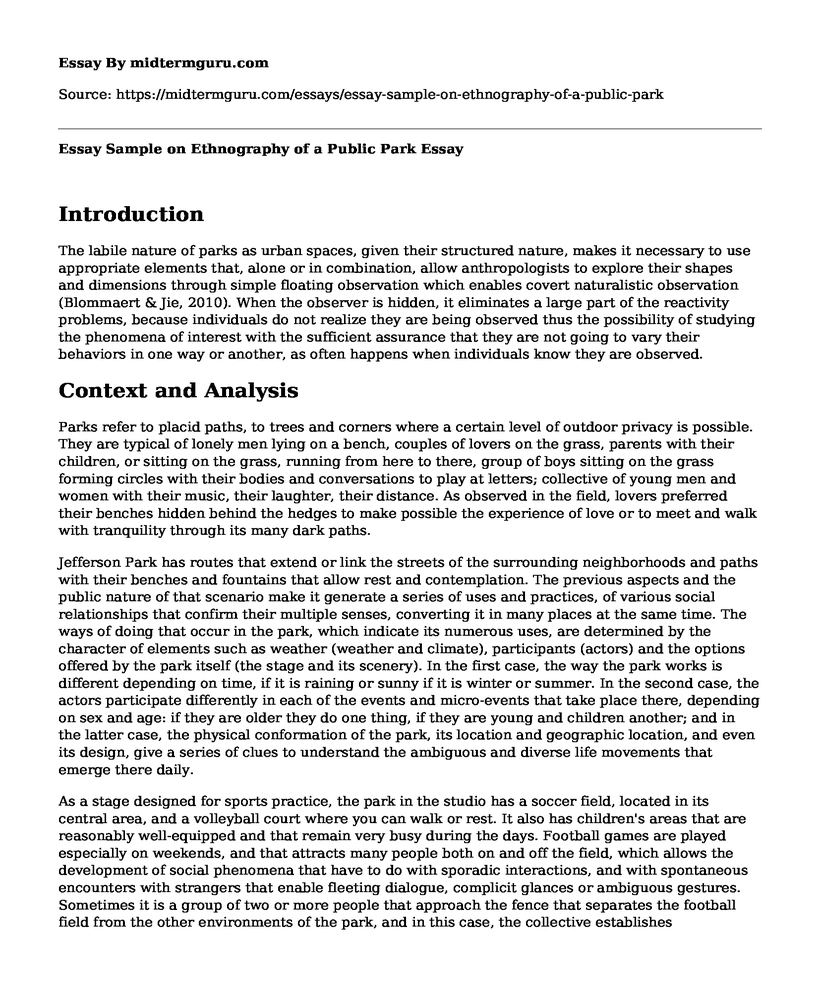Introduction
The labile nature of parks as urban spaces, given their structured nature, makes it necessary to use appropriate elements that, alone or in combination, allow anthropologists to explore their shapes and dimensions through simple floating observation which enables covert naturalistic observation (Blommaert & Jie, 2010). When the observer is hidden, it eliminates a large part of the reactivity problems, because individuals do not realize they are being observed thus the possibility of studying the phenomena of interest with the sufficient assurance that they are not going to vary their behaviors in one way or another, as often happens when individuals know they are observed.
Context and Analysis
Parks refer to placid paths, to trees and corners where a certain level of outdoor privacy is possible. They are typical of lonely men lying on a bench, couples of lovers on the grass, parents with their children, or sitting on the grass, running from here to there, group of boys sitting on the grass forming circles with their bodies and conversations to play at letters; collective of young men and women with their music, their laughter, their distance. As observed in the field, lovers preferred their benches hidden behind the hedges to make possible the experience of love or to meet and walk with tranquility through its many dark paths.
Jefferson Park has routes that extend or link the streets of the surrounding neighborhoods and paths with their benches and fountains that allow rest and contemplation. The previous aspects and the public nature of that scenario make it generate a series of uses and practices, of various social relationships that confirm their multiple senses, converting it in many places at the same time. The ways of doing that occur in the park, which indicate its numerous uses, are determined by the character of elements such as weather (weather and climate), participants (actors) and the options offered by the park itself (the stage and its scenery). In the first case, the way the park works is different depending on time, if it is raining or sunny if it is winter or summer. In the second case, the actors participate differently in each of the events and micro-events that take place there, depending on sex and age: if they are older they do one thing, if they are young and children another; and in the latter case, the physical conformation of the park, its location and geographic location, and even its design, give a series of clues to understand the ambiguous and diverse life movements that emerge there daily.
As a stage designed for sports practice, the park in the studio has a soccer field, located in its central area, and a volleyball court where you can walk or rest. It also has children's areas that are reasonably well-equipped and that remain very busy during the days. Football games are played especially on weekends, and that attracts many people both on and off the field, which allows the development of social phenomena that have to do with sporadic interactions, and with spontaneous encounters with strangers that enable fleeting dialogue, complicit glances or ambiguous gestures. Sometimes it is a group of two or more people that approach the fence that separates the football field from the other environments of the park, and in this case, the collective establishes mechanisms that allow them to function as such. They also send a signal about their connection to avoid the intrusion of "strangers." The physical proximity, the relaxed and conversational tone of the conversation makes that to a certain extent the other onlookers "respect" that space and move away so as not to interfere. Three men were having a conversation when a fourth stranger walked by, and they reduced the tone indicating wanting privacy.
Joseph says that three experiences sustain the aesthetics of public space apprehended by perceptions and metaphors: the knowledge of the emigrant, experience of conversation, experience of co-presence and traffic (Li, 2008). According to one gentleman, the walk on the park was not a mere physical exercise but a cathartic state whose motivations tend to be different but always related to the ability to move both the body and the emotions that contain it. From this point of view, walking as well as constituting "a style of tactical apprehension and kinetic appropriation" is also a way of living space from inside and outside (Li, 2008). The stroller of the park, in contrast to that of the street, wanders with his self in apparent repose, in him the slowness is a time destined for contemplation. Hence his exacerbated self-absorption that necessarily merges with the surrounding landscape.
Conclusion
From the analysis, the park provides an avenue through which people interact to fulfill their individual and collective needs within their cultural frameworks.
References
Blommaert, J., & Jie, D. (2010). Ethnographic fieldwork: A beginner's guide. Multilingual Matters.
Li, J. (2008). Ethical challenges in participant observation: A reflection on ethnographic fieldwork. The Qualitative Report, 13(1), 100-115.
Cite this page
Essay Sample on Ethnography of a Public Park. (2022, Sep 19). Retrieved from https://midtermguru.com/essays/essay-sample-on-ethnography-of-a-public-park
If you are the original author of this essay and no longer wish to have it published on the midtermguru.com website, please click below to request its removal:
- Essay on Culture and Identity: Identifying Myself
- Social and Cultural Differences in Secondary Education - Essay Sample
- Essay on Multiculturalism in Workplace: My Experience of Interacting With People From Different Ethnic Communities
- Essay Sample on Multicultural Advertising Agencies
- Research Paper on Culture Expectations and Identity
- Language Barriers in Schools: Challenges Faced by Teachers and Students - Essay Sample
- Cultural Diversity: Religion - Essay Sample







